管道是一种把两个进程之间的标准输入和标准输出连接起来的机制,从而提供一种让多个进程间通信的方法,当进程创建管道时,每次都需要提供两个文件描述符来操作管道。其中一个对管道进行写操作,另一个对管道进行读操作。对管道的读写与一般的io系统函数一致,使用write()函数写入数据,使用read()读出数据。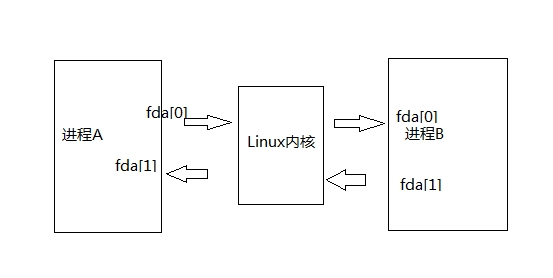
|
1
2
3
|
#include<unistd.h>int pipe(int filedes[2]); |
返回值:成功,返回0,否则返回-1。参数数组包含pipe使用的两个文件的描述符。fd[0]:读管道,fd[1]:写管道。
必须在fork()中调用pipe(),否则子进程不会继承文件描述符。两个进程不共享祖先进程,就不能使用pipe。但是可以使用命名管道。
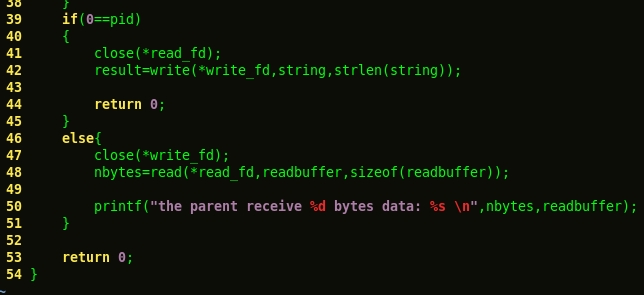

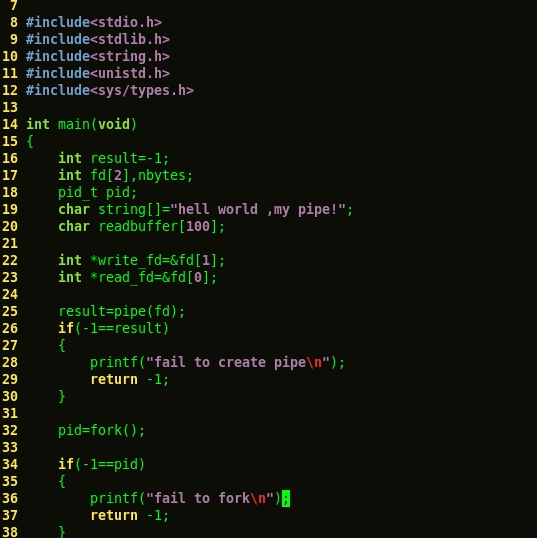
当管道进行写入操作的时候,如果写入的数据小于128k则是非原子的,如果大于128k字节,缓冲区的数据将被连续地写入管道,直到全部数据写完为止,如果没有进程读取数据,则将一直阻塞,如下: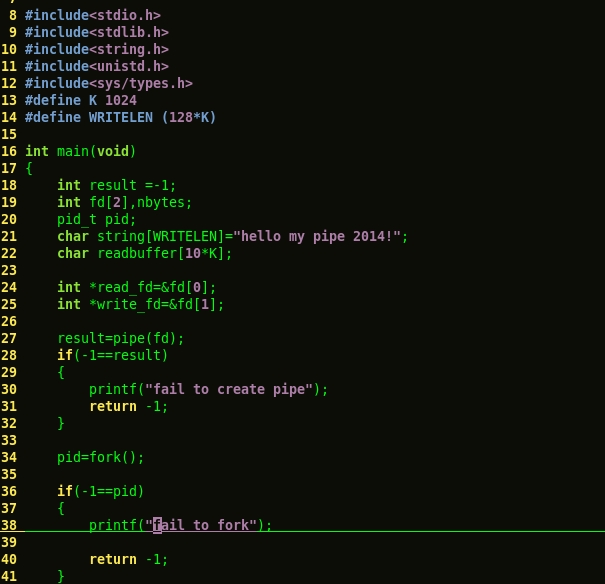
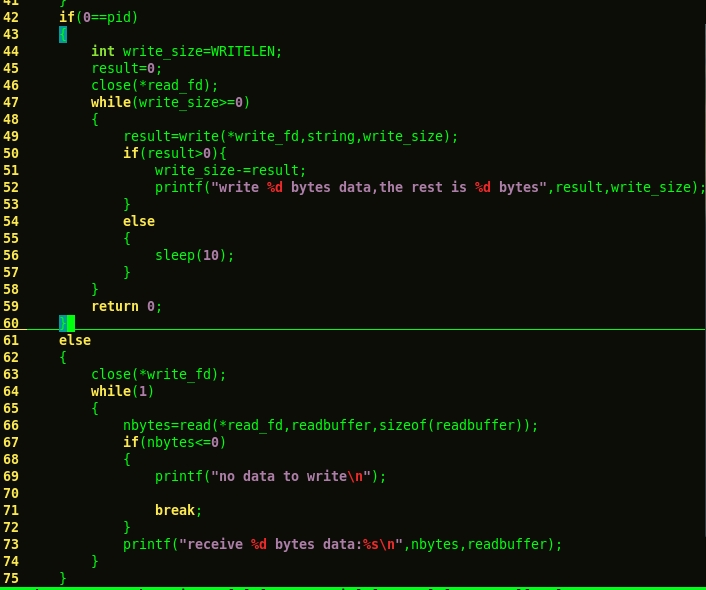

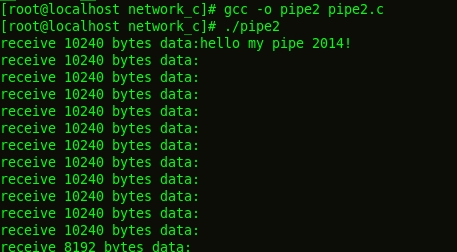
在上例程序中,子进程一次性写入128k数据,当父进程将全部数据读取完毕的时候,子进程的write()函数才结束阻塞并且
返回写入信息。
命名管道fifo
管道最大的劣势就是没有名字,只能用于有一个共同祖先进程的各个进程之间。fifo代表先进先出,单它是一个单向数据流,也就是半双工,和
管道不同的是:每个fifo都有一个路径与之关联,从而允许无亲缘关系的进程访问。
|
1
2
3
4
5
|
#include <sys/types.h> #include <sys/stat.h> int mkfifo(const char *pathname, mode_t mode); |
这里pathname是路径名,mode是sys/stat.h里面定义的创建文件的权限.
有亲缘关系进程间的fifo的例子
|
1
2
3
4
5
6
7
8
9
10
11
12
13
14
15
16
17
18
19
20
21
22
23
24
25
26
27
28
29
30
31
32
33
34
35
36
37
38
39
40
41
42
43
44
45
46
47
48
49
50
51
52
53
54
55
56
57
58
59
60
61
62
63
64
65
66
67
68
69
|
/* * 有亲缘关系的进程间的fifo的使用 * fifo 使用的简单例子 */#include "../all.h"#define fifo_path "/tmp/hover_fifo"voiddo_sig(int signo){ if (signo == sigchld) while (waitpid(-1, null, wnohang) > 0) ;}intmain(void){ int ret; int fdr, fdw; pid_t pid; char words[10] = "123456789"; char buf[10] = {'\0'}; // 创建它,若存在则不算是错误, // 若想修改其属性需要先打开得到fd,然后用fcntl来获取属性,然后设置属性. if (((ret = mkfifo(fifo_path, file_mode)) == -1) && (errno != eexist)) perr_exit("mkfifo()"); fprintf(stderr, "fifo : %s created successfully!\n", fifo_path); signal(sigchld, do_sig); pid = fork(); if (pid == 0) { // child if ((fdr = open(fifo_path, o_wronly)) < 0) // 打开fifo用来写 perr_exit("open()"); sleep(2); // 写入数据 if (write(fdr, words, sizeof(words)) != sizeof(words)) perr_exit("write"); fprintf(stderr, "child write : %s\n", words); close(fdw); } else if (pid > 0) { // parent if ((fdr = open(fifo_path, o_rdonly)) < 0) // 打开fifo用来读 perr_exit("open()"); fprintf(stderr, "i father read, waiting for child ...\n"); if (read(fdr, buf, 9) != 9) //读数据 perr_exit("read"); fprintf(stderr, "father get buf : %s\n", buf); close(fdr); } // 到这里fifo管道并没有被删除,必须手动调用函数unlink或remove删除. return 0; } |
从例子上可以看出使用fifo时需要注意:
*fifo管道是先调用mkfifo创建,然后再用open打开得到fd来使用.
*在打开fifo时要注意,它是半双工的的,一般不能使用o_rdwr打开,而只能用只读或只写打开.
fifo可以用在非亲缘关系的进程间,而它的真正用途是在服务器和客户端之间. 由于它是半双工的所以,如果要进行客户端和服务器双方的通信的话,
每个方向都必须建立两个管道,一个用于读,一个用于写.
下面是一个服务器,对多个客户端的fifo的例子:
server 端的例子:
|
1
2
3
4
5
6
7
8
9
10
11
12
13
14
15
16
17
18
19
20
21
22
23
24
25
26
27
28
29
30
31
32
33
34
35
36
37
38
39
40
41
42
43
44
45
46
47
48
49
50
51
52
53
54
55
56
57
58
59
60
61
62
63
64
65
66
67
68
69
70
71
72
73
74
75
|
/* * fifo server */#include "all.h"intmain(void){ int fdw, fdw2; int fdr; char clt_path[path_len] = {'\0'}; char buf[max_line] = {'\0'}; char *p; int n; if (mkfifo(fifo_svr, file_mode) == -1 && errno != eexist) perr_exit("mkfifo()"); if ((fdr = open(fifo_svr, o_rdonly)) < 0) perr_exit("open()"); /* * 根据fifo的创建规则, 若从一个空管道或fifo读, * 而在读之前管道或fifo有打开来写的操作, 那么读操作将会阻塞 * 直到管道或fifo不打开来读, 或管道或fifo中有数据为止. * * 这里,我们的fifo本来是打开用来读的,但是为了,read不返回0, * 让每次client端读完都阻塞在fifo上,我们又打开一次来读. * 见unpv2 charper 4.7 */ if ((fdw2 = open(fifo_svr, o_wronly)) < 0) fprintf(stderr, "open()"); while (1) { /* read client fifo path from fifo_svr */ /* 这里由于fifo_svr有打开来写的操作,所以当管道没有数据时, * read会阻塞,而不是返回0. */ if (read(fdr, clt_path, path_len) < 0) { fprintf(stderr, "read fifo client path error : %s\n", strerror(errno)); break; } if ((p = strstr(clt_path, "\r\n")) == null) { fprintf(stderr, "clt_path error: %s\n", clt_path); break; } *p = '\0'; dbg("clt_path", clt_path); if (access(clt_path, w_ok) == -1) { // client fifo ok, but no permission perror("access()"); continue; } /* open client fifo for write */ if ((fdw = open(clt_path, o_wronly)) < 0) { perror("open()"); continue; } if ((n = read(fdr, buf, words_len)) > 0) { /* read server words is ok */ printf("server read words : %s\n", buf); buf[n] = '\0'; write(fdw, buf, strlen(buf)); } } close(fdw); unlink(fifo_svr); exit(0);} |
客户端的例子:
|
1
2
3
4
5
6
7
8
9
10
11
12
13
14
15
16
17
18
19
20
21
22
23
24
25
26
27
28
29
30
31
32
33
34
35
36
37
38
39
40
41
42
43
44
45
46
|
/* * fifo client * */#include "all.h"intmain(void){ int fdr, fdw; pid_t pid; char clt_path[path_len] = {'\0'}; char buf[max_line] = {'\0'}; char buf_path[max_line] = {'\0'}; snprintf(clt_path, path_len, fifo_clt_fmt, (long)getpid()); dbg("clt_path1 = ", clt_path); snprintf(buf_path, path_len, "%s\r\n", clt_path); if (mkfifo(clt_path, file_mode) == -1 && errno != eexist) perr_exit("mkfifo()"); /* client open clt_path for read * open server for write */ if ((fdw = open(fifo_svr, o_wronly)) < 0) perr_exit("open()"); /* write my fifo path to server */ if (write(fdw, buf_path, path_len) != path_len) perr_exit("write()"); if (write(fdw, words, words_len) < 0) /* write words to fifo server */ perr_exit("error"); if ((fdr = open(clt_path, o_rdonly)) < 0) perr_exit("open()"); if (read(fdr, buf, words_len) > 0) { /* read reply from fifo server */ buf[words_len] = '\0'; printf("server said : %s\n", buf); } close(fdr); unlink(clt_path); exit(0);} |
以上就是本文的全部内容,希望对大家的学习有所帮助,也希望大家多多支持服务器之家。
原文链接:http://www.cnblogs.com/kunhu/p/3608109.html













